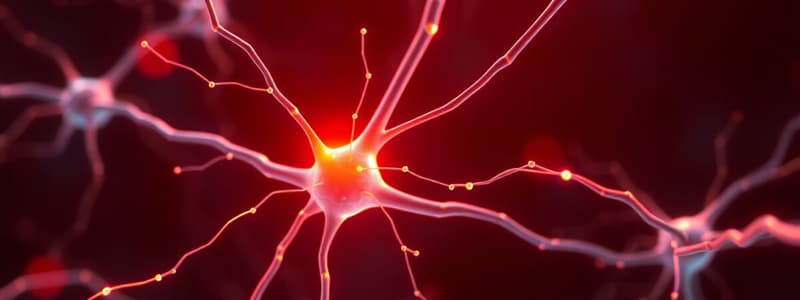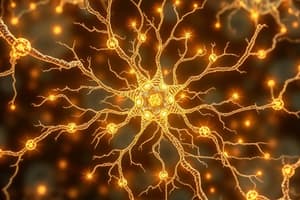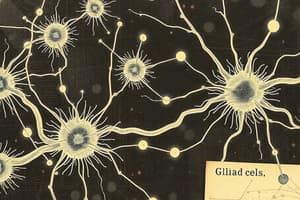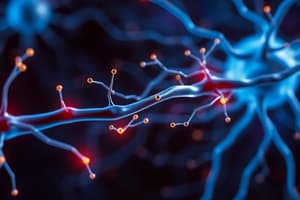Podcast
Questions and Answers
What term describes a nerve impulse that travels towards the brain and CNS?
What term describes a nerve impulse that travels towards the brain and CNS?
- Motor
- Afferent (correct)
- Sensory
- Efferent
What is the site called where a nerve impulse jumps from one neuron to another?
What is the site called where a nerve impulse jumps from one neuron to another?
- Neurotransmitter
- Axon terminal
- Synaptic knob
- Synapse (correct)
Which chemical is stored in synaptic vesicles and released during synaptic transmission?
Which chemical is stored in synaptic vesicles and released during synaptic transmission?
- Dopamine
- Endorphin
- Serotonin
- Neurotransmitter (correct)
Local anaesthetics inhibit nerve transmission by affecting which ion channel?
Local anaesthetics inhibit nerve transmission by affecting which ion channel?
What condition is characterized by excessive nerve impulses leading to severe pain?
What condition is characterized by excessive nerve impulses leading to severe pain?
What triggers the release of neurotransmitters from synaptic vesicles?
What triggers the release of neurotransmitters from synaptic vesicles?
Which of the following describes the effect of reactivated herpes simplex virus related to trigeminal nerve?
Which of the following describes the effect of reactivated herpes simplex virus related to trigeminal nerve?
Which of the following statements about action and inactivation of neurotransmitters is correct?
Which of the following statements about action and inactivation of neurotransmitters is correct?
Study Notes
Nerve Impulses
- A nerve impulse is initiated by a stimulus or the passage of an impulse from another nerve.
- Afferent (sensory) nerves transmit impulses to the brain and Central Nervous System (CNS).
- Efferent (motor) nerves transmit impulses from the brain and CNS.
- Nerve impulses are also known as action potentials.
- Nerve impulses travel down the neuron.
Synaptic Transmission
- Nerves are not directly connected.
- The point where a nerve impulse jumps from one nerve to another is called a synapse.
- There are approximately 1000 trillion synapses in the brain.
Neurotransmitters
- Synaptic knobs contain synaptic vesicles.
- Synaptic vesicles are membrane-bound sacs that store neurotransmitters.
- Neurotransmitters are chemical messengers released into the synaptic cleft.
- The journey of a neurotransmitter starts with synthesis in the nerve cell body.
- Neurotransmitters are actively transported along axons and stored in synaptic vesicles.
- They are released by exocytosis in response to action potentials.
- They diffuse across the synaptic cleft.
- Neurotransmitters act on specific receptor sites on the post-synaptic membrane.
- The action of neurotransmitters is short-lived.
- After action, neurotransmitters are inactivated by enzymes or taken back into the synaptic knob.
Local Anaesthetics
- Local anaesthetics block nerve transmission to pain centers in the central nervous system.
- Local anaesthetics bind to and inhibit the function of sodium channels in the cell membrane of nerve cells.
- This action obstructs the movement of nerve impulses near the site of injection.
- Awareness and sense perception in other areas remain unchanged.
Neuralgia
- Excessive nerve impulses can result in neuralgia.
- The most common type of neuralgia is trigeminal neuralgia.
- The Herpes Simplex Virus can lie dormant in the trigeminal ganglion.
- Reactivation of the herpes simplex virus causes it to travel down the trigeminal nerve, emerging on the lip and causing cold sores.
Studying That Suits You
Use AI to generate personalized quizzes and flashcards to suit your learning preferences.
Related Documents
Description
This quiz covers the essential concepts of nerve impulses, including their initiation, transmission, and the role of synapses and neurotransmitters. Dive into the fascinating mechanisms of how signals are transmitted in the nervous system and explore the importance of synaptic connections. Perfect for those studying neuroscience or biology!




